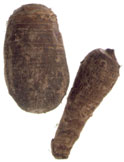"French fry pancakes"
These really are just a version of potato pancakes, using yucca. My kids, of course, love fries, so I called them french fry pancakes. They're a hit. Here's my recipe:
- 2.5 lbs yucca, either frozen or fresh.
- 1 small onion
- cooking oil
- pam original cooking spray
- thyme, basil, cilantro or parsley
- 1 teaspoon sea salt
- 1 tablespoon lemon juice
- 1/4 cup homemade broth -- I use low-fat chicken
Boil the yucca with lemon juice for roughly 45 minutes, depending on how big the chunks are. Strain, let cook slightly. Remove the tannish core stem that will become visible after cooking.
Put yucca into food processor and mash it down. Then, in mixing bowl, add yucca, your choice of spice (I use 1 tsp thyme), sea salt and broth, mix well.
Put 1 tbsp cooking oil in pan and heat to medium high temp. Wet hands before handling the yucca mix. Scoop a dollar-sized amount of yucca mix and shape into a pancake. Cook a few minutes each side until golden brown.
This recipe is very adaptable. You can cut the oil and just cook with Pam Original, for example, to cut down on fat. You may use your choice of herb. And, you may use your choice of broth.
In addition, you can use this mix to make yucca pancakes, yucca balls, yucca logs, or even a yucca dough by mixing in some flour. I haven't tried that yet, but I plan to. And, if you can make a yucca dough, then you could make yucca noodles or yucca gnocchi, just like you would with potato.
By the way, I found yucca -- both fresh and in 5 lb frozen bags -- at a local Asian grocery that also carried some South American foods. So, look either in South American or Asian groceries for this. Cost was $1/lb.








